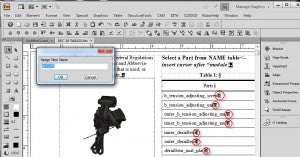Part (1) Reasons to upgrade from FM 7.x to FM 11: Catalogs, UI, rich media and more
A sizable group of FrameMaker users are still using FrameMaker 7.x (7.0, 7.1 or 7.2). These versions were released in 2002, 2003 and 2005 respectively. Obviously the product has changed substantially in 8 to 11 years. It is a testament to how far ahead of its time version 7 was for those still using it. There are numerous reasons why some users may have postponed upgrading. This is the first in a series of blogs that will touch on some of the more compelling reasons to upgrade from older versions of FrameMaker to version 11, which has been available since 2011.
The following sections touch on just a few of the advantages we will be covering more in depth with this series of blogs.
(1) Easier user interface (UI)
The current release of FrameMaker has a completely redesigned user interface that is more in line with other Adobe products. Although it takes a day or two for some long-time veterans to adjust to the new UI, it is much easier for new, non-FrameMaker users to grasp. This is an important consideration if your company merges with a division that has been using Microsoft Word, or some other product that has a more “familiar” user interface to the general public. Long-term FrameMaker users will find many time-saving improvements in the new UI as well.
My observation has been that with new users, training time and ramp up time on mastering workspaces is substantially shorter than with the old user interface. _This is especially true in terms of structured, XML editing, which has 2 additional “views” introduced with FrameMaker 11. _Watch for a blog that will focus on many aspects of this one benefit.
(2) Improved catalogs and style management
Beyond the user interface, one major convenience is improved paragraph, character and table catalogs that have improved housekeeping tools. The screen capture below has a red circle that highlights the pre-FrameMaker 9 method of viewing available table styles in a “catalog.” Only a temporary pull-down menu within the Table Designer could reveal the styles to choose from. FrameMaker 11 has a dedicated Table catalog and a number of housekeeping tools for identifying styles in use. FrameMaker 11 has even extended catalogs to include global management of anchored frames and graphic objects with the Object Style catalog. More information to come in future blogs.

https://blogsimages.adobe.com/techcomm/files/2013/01/A-Table-Catalog-FM7.jpg
Table Catalog circled in FrameMaker 7.2

https://blogsimages.adobe.com/techcomm/files/2013/01/FM11-Catalogs.jpg
New Table and Object Style Catalogs in FrameMaker 11
(3) Rich, multimedia support
The current release of FrameMaker 11 supports a wide array of rich media formats, including Flash, mp4, various video and 3-D graphics formats. Once such a graphic is imported into FrameMaker, it becomes an interactive experience for the user in published PDF output. SWF files from Captivate can create a “movie” within an anchored frame that can replace a dozen sequential screen captures. FrameMaker 11 introduces the ability to automatically generate a hyperlinked table of parts, views or animations, derived from a named 3D graphic, as in the screen capture below.

https://blogsimages.adobe.com/techcomm/files/2013/01/hyperlink-table.jpg
Note: the red circles indicate where hypertext link markers were automatically inserted by FrameMaker 11 when the parts were extracted during the Link Table to Graphic command
(4) True, native XML support in DITA, S1000D and XML
Earlier versions of FrameMaker supported “structured documents.” But, such documents had to have a *.fm suffix, and were essentially a proprietary FrameMaker binary format with powerful EDD rules, etc., embedded in the file. Whenever the user wished to share “real” XML, he/she had to “save as” XML. Watch for a future blog that will cover the many pitfalls that have been eliminated by new, cleaner methods used in FrameMaker 11. In addition, features like Intelliprompt, a DITA “strawman” and XML code view help create a truly authentic DITA authoring environment.

https://blogsimages.adobe.com/techcomm/files/2013/01/DITA-strawman.jpg
Screenshot of a new DITA Topic with “strawman” placeholder text in FrameMaker 11. Notice that the document is saved in *.xml format, not binary, structured *.fm.
(5) PDF review workflow
The current release of FrameMaker allows you to save PDF for review that can be annotated by reviewers using free Acrobat Reader. Once the review cycle is complete, the actual annotations can be imported “in place” in the source FrameMaker document. If you are using Tech Comm Suite, you can employ a collaborative review cycle in which various reviewers annotate the same PDF review file on a server, or “in the cloud.”
Too many benefits to list
Other benefits to be covered in this blog series will include multi-user track changes, support in DITA/XML for processing instructions which can invoke transformative XSLT style sheets, Unicode support and the ability to swiftly output content to ePub format via Tech Comm Suite.
Watch closely for this numbered series of blogs appearing daily for the next few days. You will gain a fuller understanding of how much time and money you can save by upgrading to FrameMaker 11.
More reasons listed in subsequent blogs:
See the second reason for upgrading in our blog “Part (2) Reasons to upgrade from FM 7.x to FM 11: Workspaces and a Friendlier UI.”